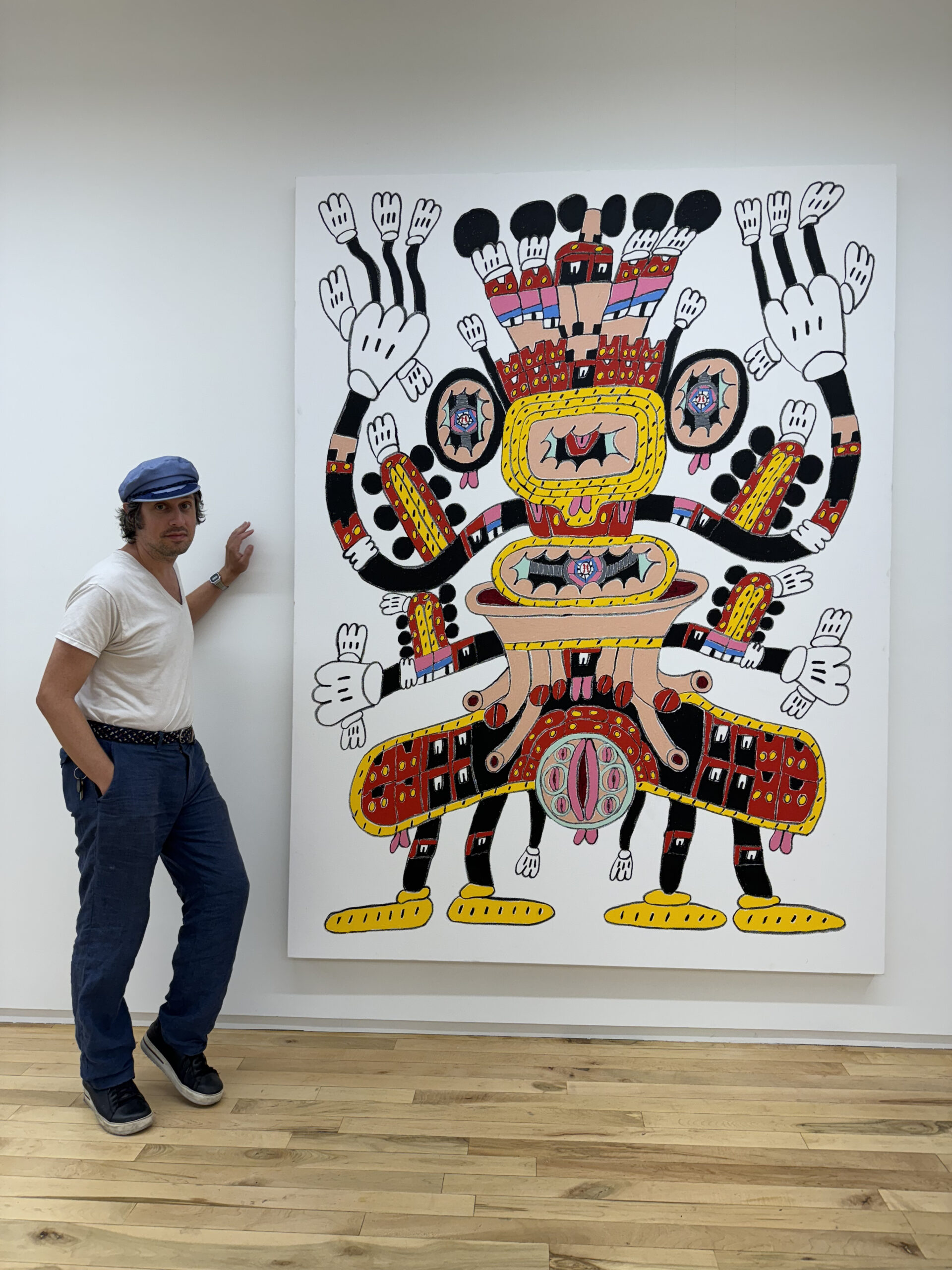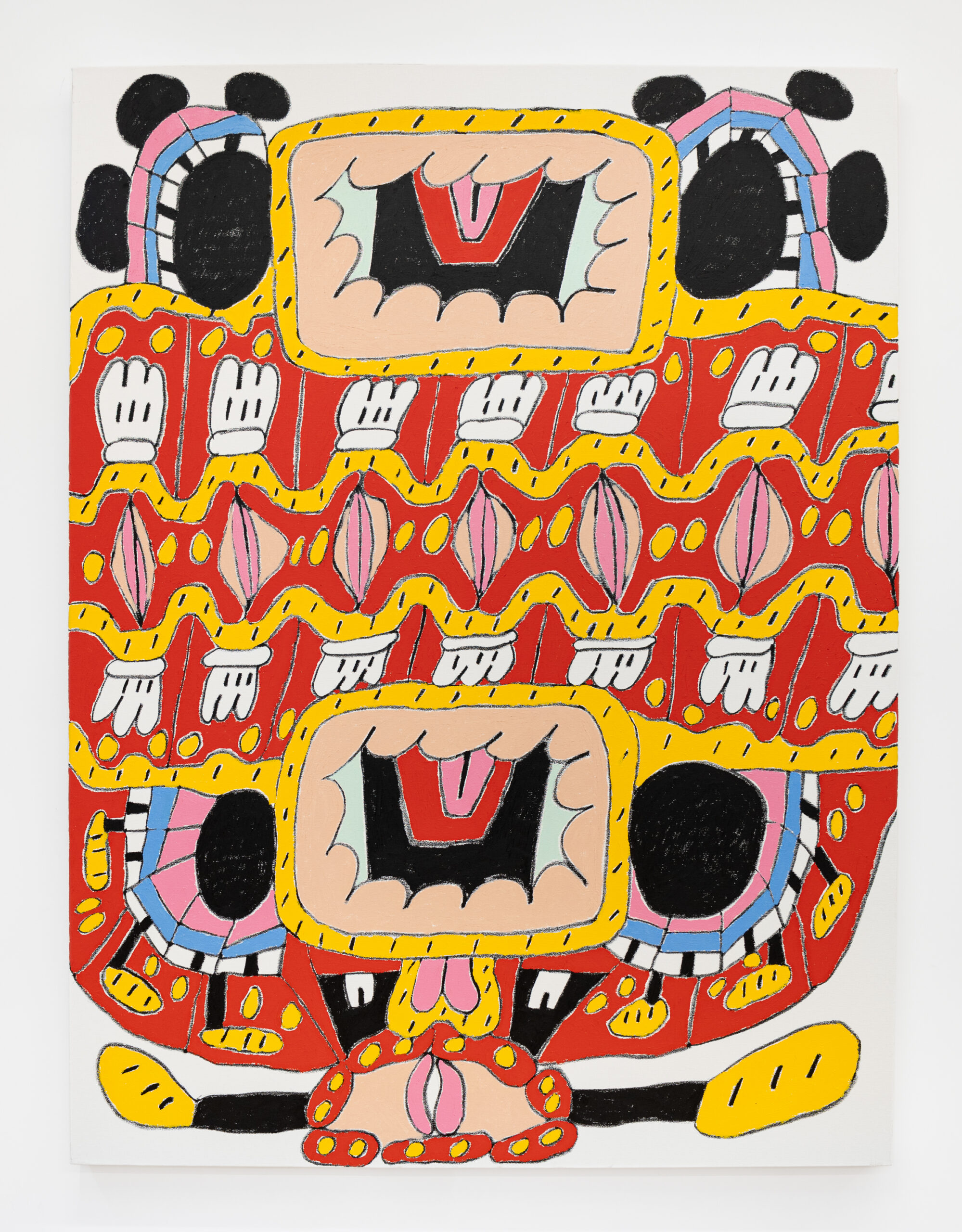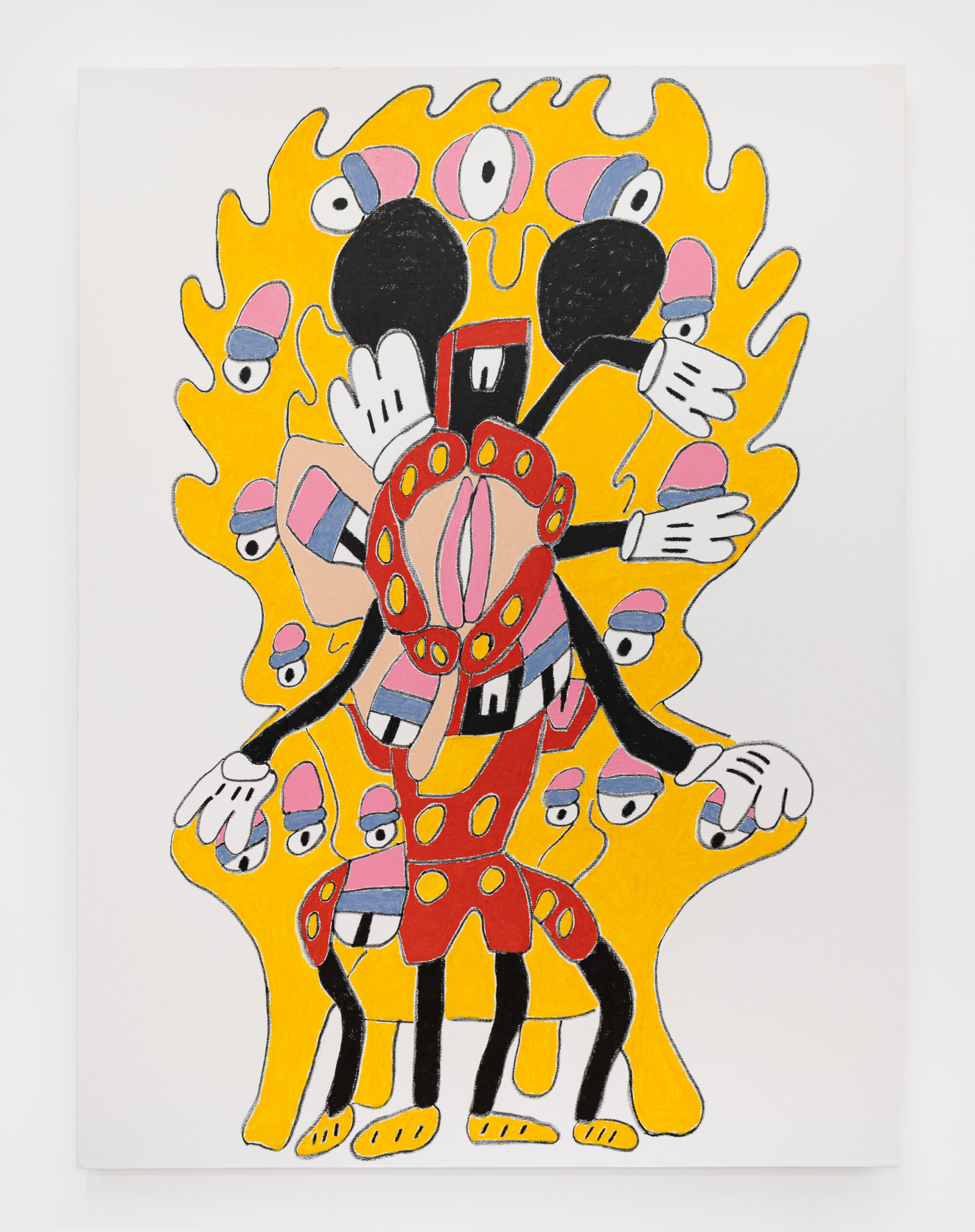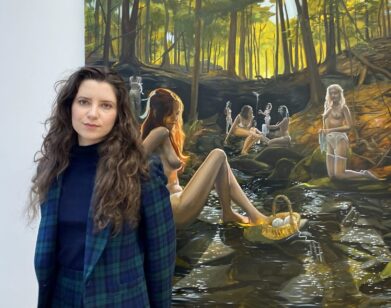OPENING
Adam Green of The Moldy Peaches Still Thinks Art Can Save the World
The darling of New York’s indie scene isn’t leaving music for art—he’s merging them. Since departing The Moldy Peaches, Adam Green has released ten solo albums, a collaboration with Binki Shapiro, and two films. He’s penned a graphic novel, War And Paradise (2019), and an epic poem, MDVL: 1,000 Years of Dark Ages (2021). But none of this is haphazard. By design, Green is steadily integrating his endeavors into a cohesive universe exploring technology, religion, and human nature.
Green’s presented numerous art shows since going solo twenty years ago, but his ten works of oil stick on canvas in Transfiguration of the Comedian, now on view at DIMIN gallery downtown, feel different. They’re larger and more polished, all centered on a deity Green calls “The Comedian,” one of many gods he’s conjured. Here, the Comedian assumes disparate avatars, from the Tibetan Mandala to the Jewish Sefirot. Over espresso and San Pellegrino, Green explained the roots of his polymathy, his new visual language “houseface,” and how art might save the world.
———
VITTORIA BENZINE: How’s your summer going?
ADAM GREEN: I went to Japan with my family for about 10 days, which was cool.
BENZINE: Where in Japan?
GREEN: Tokyo and Kyoto.
BENZINE: Had you been there before?
GREEN: I haven’t been there in over 20 years. I supported Ben Kweller on his tour for Sha Sha. That was the last time I was there. But coincidentally, I bumped into Ben Kweller again in Japan.
BENZINE: Serendipity. Did you guys kick it?
GREEN: Yeah, we sang some karaoke.
BENZINE: What a treat for everybody there.
GREEN: Oh, I hope so. It was fun.
BENZINE: So you’ve done a number of group and solo art exhibitions over the past decade or so. As a young teenager, did you always plan to be a full-on polymath?
GREEN: Growing up, I really admired Harry Smith, who is a really great example of that. He had interests spanning all kinds of pattern recognition: cool Native American tapestries, incorporating elements of Zohar and Kabbalah into his work, assembling the American Folk Anthology, which is a really influential collection of old American folk songs, a collection of Ukrainian Easter eggs, and a collection of paper airplanes he found in the street. And he’s analyzing all these things for the ways they resonate in culture. I was always interested in people that could make connections between things. As I got older, I was exposed to The Holy Mountain by [Alejandro] Jodorowsky by my bandmate, Kimya Dawson, who had a bootleg VHS cassette of the movie. I was a teenager, and I couldn’t believe that anyone had ever made a movie like Holy Mountain. So I spent a bunch of years trying to dissect what that movie was all about and follow all those ends. I’ve been on tour since I was 19 years old with The Moldy Peaches, and then by myself. I think I was just looking for patterns.
BENZINE: Yeah. You had mentioned earlier as we were walking around this exhibition that a lot of these oil stick pieces feel like drawings to you. I imagine that drawing is something that you’ve done throughout your life.
GREEN: Yeah.
BENZINE: Did you imagine yourself becoming a visual artist?
GREEN: Yeah. I liked to draw my whole life. I used to draw on tour in a little notebook with a ballpoint pen. I had an exhibit of those drawings at Loyal Gallery in Malmo in 2005. It was my first art show. But I didn’t seriously consider painting until I was in my mid-20s, when I started realizing that it was kind of connected to my music. I really love Max Beckmann’s triptychs, and kings and crowns and clowns and harlequins and birds, all this stuff that appears in Beckmann paintings. I started thinking about making my own symbolic universe, which I started to do on my first solo album, Garfield. And some of those things, like baseball diamonds, which appear on that album, are in the show. In my mind, they’re kind of like quantum computers that have this hyperlink quality and can power all these machines to have infinite possibilities. I think because I didn’t go to proper schooling or higher education, I learn by absorbing things about a subject. So I learned a lot about Ancient Rome by reading a really great book about Twombly by Richard Leeman. I just wrote down every single thing that he referenced in the whole book and researched it to the point where I understood Ancient Greece and Ancient Rome through just the Twombly paintings.
BENZINE: Right.
GREEN: For me, creating art is about learning something about the fabric of the world. I made this system called Houseface. Actually, I think I have a picture. I started to develop it during that second show I had. It’s an alphabet of reducing the facial features of cartoon characters like Big Bird, Garfield and Elmo into these sort of cubic simplifications. I got into the Mondrian period that people call Neoplasticism, which to me is the pinnacle of video game textile reality, almost like 8-bit. So it’s almost like cartoon character crack, where it’s just a reduced crystal of those forms. And from that, I made a symbolic alphabet that I’ve kind of been adding to. I may have too much of it now.
BENZINE: It’s like the process of drawing runes and sigils.
GREEN: Yeah, because I think of it as a complete alphabet. It’s really great because you can recombine the symbols and they become other things. The process of making the Houseface is sort of like brick laying, which also is like pixels. They’re like mosaic pixels that you can chip away at. And in a way, they can be snapped onto the grid of reality with a lot of ease. I like the idea of art down to a fractal level being made out of hybrid materials, because the elements of the art hyperlink with each other. I want people to think on multi-levels about the art and the sentimental attachments that they have to the symbols themselves.
BENZINE: Yeah.
GREEN: As a musician when you see music notes or record music on a visual digital interface like Pro Tools, you can see the fibers of the sounds on a grid. I think of these bricks like that. To me, to draw them is like writing music. They’re trying to trace my interior landscape and put it out into the world, and I think that’s my mission statement as an artist.
BENZINE: Beautiful. So when it comes to this body of work in Transfiguration of the Comedian, do you sort of work in a similar way, translating symbols through Houseface and then using those bits to arrange them into these really maximalist compositions?
GREEN: I did. I think I had the luxury of time, so I did lots of different sketches of different Comedians, and these were my favorite ones. So in this case, I was using a subset of the Houseface symbols. There’s more, but this is six or eight symbols. I think of it as seeing the soul of this deity from a different dimension. For example, with this one, I actually thought of it almost like a Rothko.
BENZINE: Like “Glory of Love”?
GREEN: Yeah, yeah. That one over there. I always liked how Rothko paintings are like portals that you go into. And apparently, he wanted you to stand a certain distance away from it so that you could feel the portal of it. I also saw some sketches that Rothko made before he would do his portals, and he would sometimes sketch it out in lines, which I thought was interesting. But I also thought of a lot of them as science lab slides, where you slice a cross section of something and look under a slide. Maybe even like a sausage or a deli meat slicer. Each piece of prosciutto looks kind of different. But if you look at a sequence of them, you can see where they came from. So in this one, The Comedian took over the chair.
BENZINE: Ah, yes. In “Hostile Takeover.”
GREEN: This is a deity I have called Lumambros. That’s the creative deity that’s associated with world-making, in my world. Whereas The Comedian, I can’t tell. It’s starting to become associated with hybridity itself. I almost think of it as an AI. It’s like a god of novelty that can’t actually make anything new, but somehow represents that to people. I’ve really been interested in experimenting with all these AIs that seem to be great at hybridity. It seems to be the best thing that it does. It just instantly mashes anything up that you want.
BENZINE: I was really impressed reading War and Paradise, bearing in mind that that came out in 2019. You’re ahead of the curve on AI for sure. And on blockchain and even deep fakes.
GREEN: Oh, thanks. The thing is, my wife is a technologist. She works for Google, but she runs a group called Jigsaw, which is under the Google umbrella. They do a lot now with trying to bridge the way that people are communicating online so that they can find common ground, which I think is a really neat project. It’s the future of the public square. I think a lot of people have forgotten what it’s like to just be in a room full of people and have different viewpoints from them, which used to be really common. Anyways, Yasmin is a genius and she edits everything I do. Once I’ve communicated it to her and she’s happy and entertained, then that project is done.
BENZINE: That’s beautiful. And it kind of feeds into looking at the evolution of your visual arts practice, from the style of Hot Chicks through this work.
GREEN: Yeah.
BENZINE: It definitely looks more polished, and I was wondering if part of that stylistic development had to do with practicing more in the medium of graphic novels. But it seems like having that outside input from her refined your style, too.
GREEN: Of course. There’s also something called art molecules that’s started to kind of pop into my world. Art molecules are almost like, people have to decide where they go. There’s a stake in my world of where the art molecules go and who gets them.
BENZINE: So this character of The Comedian, would you say it arises from the lump sum of all your different creative avenues? Or is this a character that appears explicitly in one project or another?
GREEN: Well, I made a medieval poem, which is about the cycle of the world becoming more medieval. It’s called “MDVL: 1,000 Years of Dark Ages,” and the best way to experience it is through the film I made with animator and director Tom Bayne on YouTube. But the character of The Comedian appears in it, and he’s on trial as sort of like a heretical artist. I have not quite found exactly where The Comedian fits into my world, but he’s sort of a god of hybridity.
BENZINE: You’re very rigorous with your deities. You don’t let them off the hook or simply worship them.
GREEN: No, no. I think of it as a piece of an ornate clockwork that has to do with my spirit. I hope, as an artist, that when I communicate with people they find a commonality with my own productions. But there’s these constellations that I’ve tried to articulate in this piece. I made the Constellations of the Art Mechanism: Symbol, Noise, Void, Hybridity, Mindwheel, Gridding, Hypnotic magic, and World Making, and Resolution. That’s how I would articulate what is happening inside of me when I make a creative work. And I think of each deity as participating in the direction of those things. It’s like a way for me to worship the things that are guiding me towards making my own productions. I’m fully aware that these are the deities that govern my world, and they’re not everyone’s deities.
BENZINE: Well, I read that you have referred to yourself as the Jewish James Dean.
GREEN: I was just teasing.
BENZINE: I like it though. And of course, you’ve communed with a number of hallucinogens. So I was wondering, did drugs shape your spirituality?
GREEN: Yeah, of course. The first exercise that I did with drugs, and I still actually would recommend this to anyone, was I would take a hit of weed and write for 20 minutes. After a while, I’d take another and I would just do it for two hours. People love that Jack Kerouac had an endless scroll that he taped together to write on the road. Apparently he taped together 300 sheets of paper so he could write. I think it’s actually true. They have it in the public library now.
BENZINE: Yeah.
GREEN: Of course, taking LSD has been a big influence on me. And in The Wrong Ferrari, my first film, which was shot on iPhone, ketamine was a huge part of the plot. I wrote a lot of the script on ketamine. I found out that I could write lines on my notes app while I was on ketamine. And I think the phone notes were yellow at the time. I remember thinking, because there’s a Talmudic idea that the Torah was written with a black flame on white flame. And I felt like that with my iPhone. I felt like I was writing in laser fire on a laser screen. I was like, “Oh, this is like the tablet that Moses had.” You know?
BENZINE: Yeah.
GREEN: The ideal tablet is a plain computer screen that just has endless text scrolls. I don’t recommend doing that much ketamine, though, because it definitely made me pretty paranoid.
BENZINE: So with these new oil stick paintings that are different manifestations and views of the same deity, what was your process? Probably not ketamine this time.
GREEN: No, no. I’m off the ketamine. But in The Wrong Ferrari, I was put into a video game, and the character they turned me into was called “Awesome Adam.” The character was mentioned in the movie called Turbo Marco. And in my work, Turbo Marco became sort of like the Jesus of Nintendo. There’s a record label called Zintendo Records that signed me in the movie, which was like a metaphysical technology company. And there’s a deity in my world called Zintendoth that’s like, the god of technology and singularity. I think that influenced the Houseface alphabet and its pixelated quality.
BENZINE: And there’s a lot of Mickey Mouse translated into Houseface, it seems. Why Mickey Mouse?
GREEN: I always think Mickey Mouse is the most basic thing in the world. If you draw a painting of Mickey Mouse, it’s so played out. It’s so basic. It’s like writing a song called “I Love You, Baby” or something. But I like to use things that I know how to draw as a starting point, so Big Bird, Ninja Turtles, Mickey Mouse. It’s actually important for artists to work with materials that they’re really familiar with so that they know how to manipulate them. I’m trying to demonstrate that I can squeeze those symbols and make them do my bidding. It’s almost like I torture the symbol until it confesses to what I believe in, you know?
BENZINE: Do you know about chaos magic?
GREEN: What’s chaos magic?
BENZINE: I say I practice chaos magic, but it’s kind of a silly thing to say because everybody does. But it’s this school of thought that started to take hold in the 1970s and is generally reviled within the magic community today because people say it’s for tech bros who don’t like rules. It’s kind of like a sexed up law of attraction. The idea is that rather than the dogma of traditional magic, it acknowledges the symbols of pop culture.
GREEN: Yes.
BENZINE: So chaos magic is simply the idea that if something resonates with you to the degree that it can spur gnosis, you can use that to cast spells. But this is something that we’re all doing, right?
GREEN: Yeah.
BENZINE: It’s just whether you take agency over it or not.
GREEN: Right. I was interested in tarot cards. I love how cartoony they can be. So a thousand years from now, when no one knows those characters anymore, and they just pick it up in a tomb or something, they’re like, “This must be a deity or something.” That’s kind of how I see my work.
BENZINE: Some of my own realizations happened during psychedelic exercises over the past couple years. When I would take mushrooms, I would try to remind myself that this is always here. And when it wears off, it doesn’t go away. It’s just that you don’t see it. And then, you think about being an animal who evolved to survive. Your brain has a filtering mechanism. So no wonder I don’t see all this stuff all the time, because it wouldn’t benefit my survival.
GREEN: Of course. It’s like the William Blake quote about the door of perceptions. I do feel like there’s a layer of a spirit world, and [my art is] my own way to touch that realm in feeble human terms.
BENZINE: In your discography, 2019 looks like that year you began drawing your album covers.
GREEN: Yeah.
BENZINE: And it’s really interesting because your latest EP, Magic Spells, is referenced in War and Paradise. And referenced in your essay from January, “Constellations of the Art Mechanism.” I love this kind of upcycling of your own ideas.
GREEN: In my world, there’s sort of a canon of texts, like Turbo Marco’s letter to god, which is in War and Paradise. I think a project that I’d like to do in the near future is to make a grimoire that tells the history of the deities and the properties of them and has magic spells you can use to make them an audience. I want to have a little Library of Alexandria of canon texts that have to do with the regular world, what I was calling Regularis, which is sort of the simulation or spiritual plane that I think inside of. I’d describe it as augmented reality, because there’s always reference to the real world or the shared collective world in my work. I mean, I don’t disregard it. It’s almost like rose-tinted glasses or something that you kind of put on to see the Houseface elements overlaid on the real world.
BENZINE: It raises questions about whether you invented these deities, or whether you just activated or uncovered something that was already there.
GREEN: I don’t know. I mean, it’s really great fun for me and it gives me meaning. People seem to really enjoy it. It’s just become a fun way to participate in this world. People can come and go as they please. Some people just like one song from Moldy Peaches, or they like The Wrong Ferrari, or they like one painting I did, or the Binki Shapiro collaboration album. It’s just a big tapestry, and it’s my job to weave it.
BENZINE: It’s interesting to hear you word it that way, because I was curious to know if you see the disparate avenues of your practice drawing closer together over time.
GREEN: I’m self-consciously trying to relate them to each other, sometimes in a way that’s probably too much. My wife will be like, “You don’t even have to explain that. It’s fine.” I want Regularis to be my Met Museum. But if anything, it has a lot to do with lyrics. That might be what separates me a bit from a lot of other artists that have a gallery show. A huge amount of my investment is in lyrical phrases and using words to communicate symbols. It’s not a coincidence that I ended up at a group of symbols that I almost consider to be writing, because it’s almost like the logos of the universe that I’m interested in specifically. I think that even in magic, the word abracadabra means—the translation I heard could be fake news. But it’s “As I say, it will be.” So if I can do an abracadabra with letters and alphabets, I can cause the world to be this way.
BENZINE: I’m curious, given the numerous types of creative industries you’ve moved through, about your take on moving in the commercial art world these days.
GREEN: I mean, I think of myself as a bit of an outsider. I think of my work as artifacts in a tapestry. But as far as the ins and outs of how it works, I don’t really know.
BENZINE: And ideally, you never will?
GREEN: Hopefully. I’ve had an enormous lucky run of not having to think about it when I’ve been making art.
BENZINE: Do you think that art can save the world?
GREEN: Sure. I don’t know why people don’t seem to think that anymore. It seems like it kind of could.









